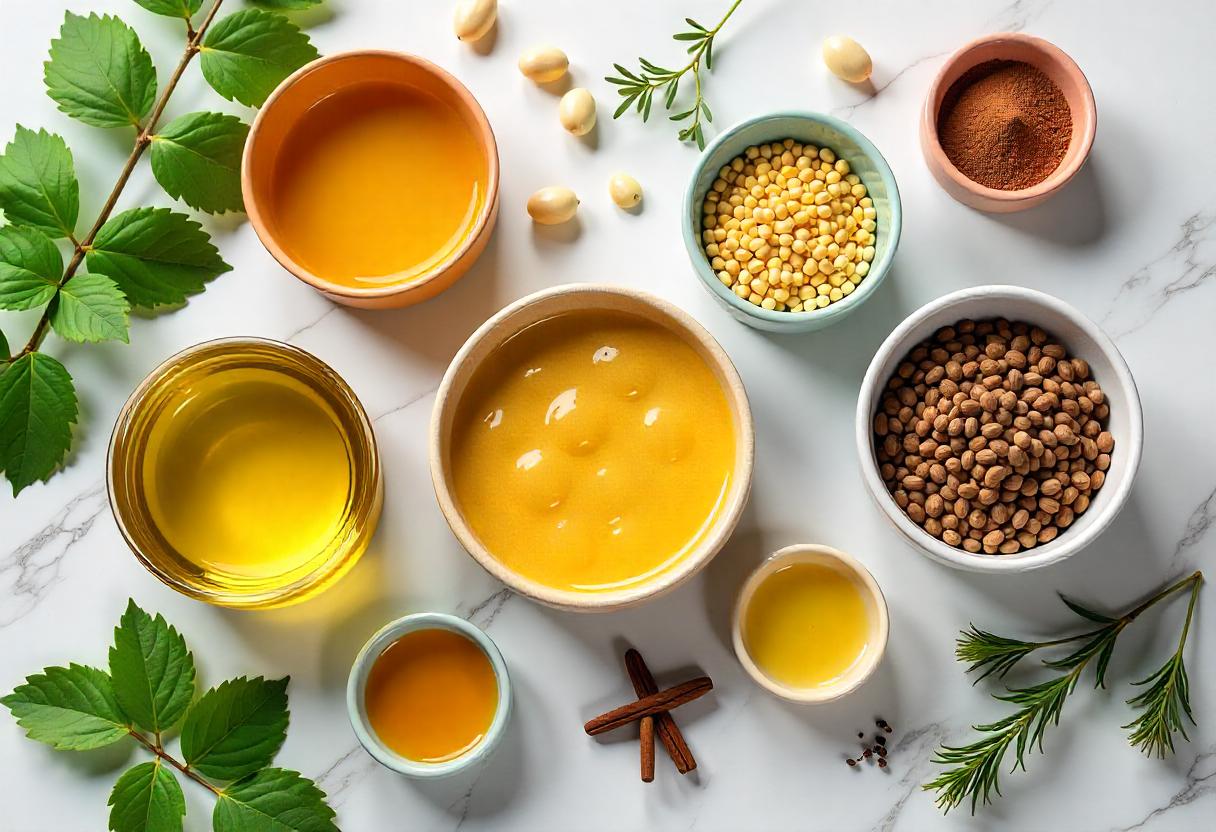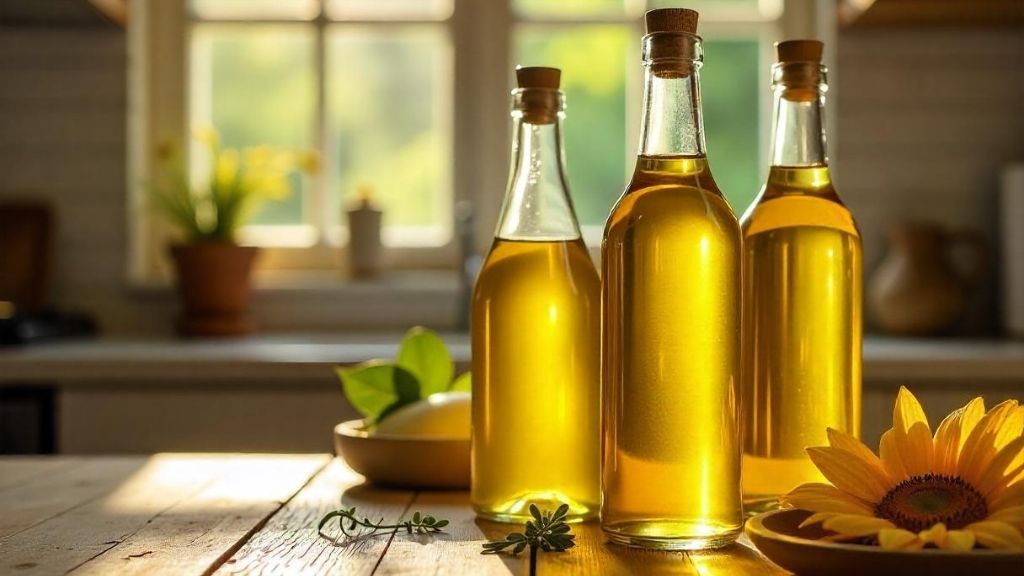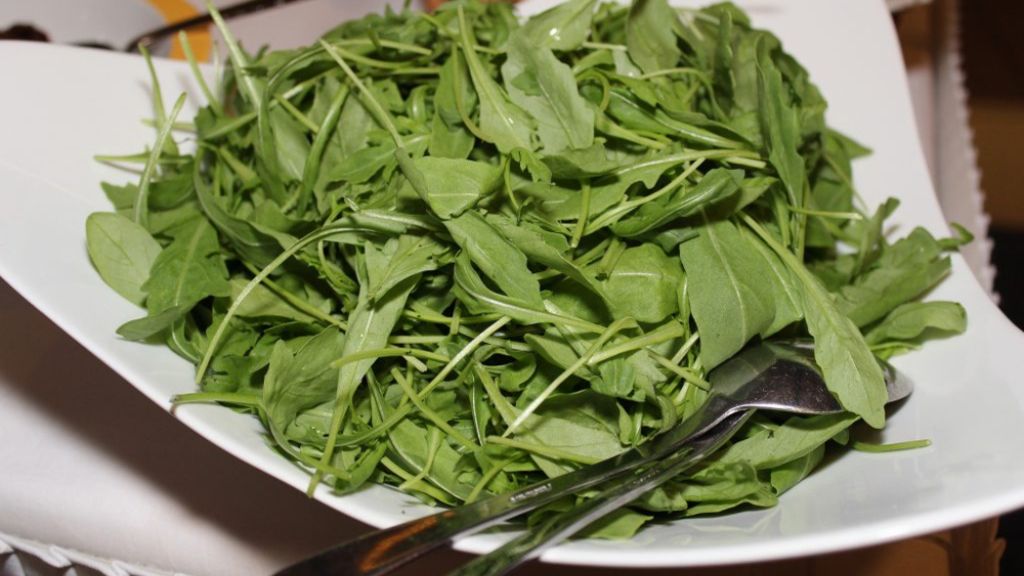Introduction to their effects on cooking oil and health
When it comes to cooking, the oil you chosen can create a significant difference not only for the taste of your food, but also for your overall health. Have you ever stopped considering that when you are snatching vegetables or preparing a stir, then what really goes into your pan? It appears that simple decisions can affect your risk for your heart health, swelling levels and even chronic diseases.
Why the Oil You Choose Matters
Cooking oils are not just passive ingredients that help prevent food from sticking to your pan. They are active participants in your diet that contribute to fatty acids and other compounds that become part of the cellular structure of your body. Each spoon of oil contains about 120 calories and 14 grams of fat – meaning that they pack a significant nutrition punch in a small amount.
Different oils have different types of fat and beneficial compounds such as polyphenols and vitamins. Some can withstand high temperatures without breaking in harmful compounds, while others are better suited to drip on finished dishes. Creating informed options that oil to keep in your kitchen can be cumulative benefits to your health over time.
Key Factors in Evaluating Cooking Oil Health Benefits
When determining cooking oil health, nutritionists see many major factors:
Fat structure – especially saturated ratio for unsaturated fat
Omega -3 to omega -6 ratio -with equal equilibrium with equilibrium
Smoke Point – The temperature at which the oil starts to break
Processing methods – Low processing means more nutrients are usually maintained
Antioxidant material – compounds that fight oxidative stress in the body.

Understanding Fat Profiles in Cooking Oils
The health of cooking oils comes down to their thick creation to a large extent. But with such a contradictory information about swimming around the fat, it can be difficult to know which oils are really beneficial.
Saturated versus unsaturated fat
For decades, saturated fat was considered universally unwell, while unsaturated fat was praised. While the picture is now more fine now, there is still a good reason to take the side of oils with high unsaturated fat content for cooking everyday.
Saturated Fat – Which remains solid at room temperature – LDL (poor) is associated with an increase in cholesterol levels in case of maximum intake. They are mainly found in animal fat and tropical oils such as coconut and palm.
Unnecessary fats on the other hand, LDL can help reduce cholesterol levels when they change saturated fat in the diet. These come in two main varieties: monounsaturated and polyunsaturated.
Monounsaturated fat
Monounsaturated fatty acids (MUFAS) are considered some healthy fat available. They are associated with it:
Lower inflammation
Low risk of heart disease
Better insulin sensitivity
Better cholesterol profile
Monoonsaturated fat rich oils are more stable when they are hot, giving them excellent options for cooking. The Mediterranean diet, which is constantly rated as one of the health patterns in the world, has olive oil – mainly monounsaturated.as its primary cooking fat.
Polyunsaturated Fats
Polyansechurated fatty acids (PUFA) include the required omega -3 and omega -6 fatty acids that our bodies cannot produce on their own. While both are necessary, the specific western diet has much more omega -6S than omega -3S.
The unbalanced ratio of these fat can promote inflammation and oxidative stress. Ideally, we should consume these fat in proportion to close to 1: 1, but modern diets often have a ratio of 15: 1 or 20: 1 in favor of omega -6.
Polyunsaturated fat is less stable when high oil is hot, making them better for cold applications such as salad dressing or low heat cooking.
Smoking points and why they matter
Another important factor in evaluating cooking oils is their smoking point – the temperature at which one oil starts smoking and breaks. When the oil reaches the point of its smoke, it not only provides an unpleasant taste for food, but also produces a harmful compounds called free radicals and aldehyde, which can damage cells and potentially increase the risk of cancer.
Oil with high-smoke points (above 400 ° f/204 ° C) are better suited for high-sum-cooking methods such as frying and sect, while people with low smoke points are the best reserved for low-heat cooking or finishing dishes.
Now when we understand these basic things, let’s check how five common vegetable oils are piled up.
5 most common vegetable cooking oil rank
I ranked these oils based on their overall health profiles, considering fat structure, processing methods, versatility and nutritional benefits.
#5 soybean oil
Soybean oil is omnipresent in processed foods and is one of the most widely eaten oils in the US. Despite its prevalence, it is the lowest in our health-focused list.
Nutritional Profile and Health Implications
Soybean oil includes:
15% saturated fat
23% monounsaturated fat
58% polyunsechurated fats (mainly omega -6)
The primary anxiety with soybean oil is its high omega -6 content relative to omega -3. With a ratio of about 7: 1, regular consumption contributes to problematic imbalance in the typical western diet.
Recent researches have linked high consumption of soybean oil to obesity, diabetes and inflammatory conditions. A 2020 study from the University of California, Rivaraside found that soybean oil consumption in mice led to gene expression changes that could promote obesity and neurological issues.
Additionally, most soybean oil is highly sophisticated and often comes from genetically modified soybeans, which increases concerns for some consumers.
Soybean uses best for oil
If you use soybean oil:
Reserve it for timely use instead of cooking daily
Use it mainly for medium-summer applications (Smoke Point: 350 ° F/175 ° C)
Consider the discovery of organic, non-GMO varieties if possible
#4 canola oil
Canola oil, which is particularly obtained from a variety of rapids, has been marketed as a heart-health option due to relatively low-preferred fat content.
Health benefits and concerns
Canola oil includes:
7% saturated fat
63% monounsaturated fat
28% polyunsaturated fats.
On paper, canola oil looks promising with its high monounsaturated fat content and better omega -6 ratio (about 2: 1) from omega -3. It also contains good amounts of vitamin E and vitamins.
However, traditional canola oil is highly processed using high heat and chemical solvents such as hexons, which can lower oil quality and destroy many of its beneficial compounds. The refining process also removes natural omega -3 content, which is unstable and prone to ransom.
Some studies have suggested that frequent heating of canola oil (as in deep firers in restaurants) can cause potentially harmful compounds and trans fats.
Optimal cooking application
While using canola oil:
Choose cold-pressed or explore-pressed varieties when possible
It works good for baking due to its neutral taste
Its relatively high smoke point (400 ° f/204 ° c) makes it suitable for medium-high heat cooking
Consider this for timely instead of daily use
#3 sunflower oil
Sunflower oil, pressed with sunflower seeds, comes in many varieties depending on the oleic acid material. The high-licit version is much better for health than regular variety.
Nutritional breakdown
Standard sunflower oil includes:
11% saturated fat
20% monounsaturated fat
69% polyunsaturated fats (mainly omega -6)
High-licit sunflower oil includes:
9% saturated fat
82% monounsaturated fat
9% polyunsechurated fat
The difference is sufficient. Regular sunflower oil like soybean oil is an adverse omega -6 to omega -3 ratio. In high-licit varieties, however, mainly there are monounsaturated fats similar to olive oil, making them more stable and healthy for cooking.
Sunflower oil provides vitamin E, an important antioxidant that protects cells from damage. One tablespoon provides approximately 5.6 mg vitamin E, which is about 37% of the daily recommended value.
Ideal uses in the kitchen
For cooking with sunflower oil
Always choose a high-olic version when possible
Use it for sautéing and medium-high heat cooking (Smoke Point: 440 ° F/227 ° C)
Its light, neutral taste makes it versatile for various dishes
It works well in salad dressing and marinades
#2 additional virgin olive oil
Additional virgin olive oil (EVOO) is the cornerstone of the Mediterranean Diet for millennium, and Additional virgin olive oil (EVOO) is the cornerstone of the Mediterranean diet for millennium, and modern research continues to validate its many health benefits.
Mediterranean Standards
Evoo includes:
14% saturated fat
73% monounsaturated fat
11% polyunsaturated fat
What really separates Evoo, it is not just its fat profile, but has its incredible prosperity in bio -active compounds. It contains more than 30 different phenolic compounds with antioxidants and anti-inflammatory properties.
Research has added regular consumption of additional virgin olive oil.
The risk of heart disease decreases
Cancer low rates
Better cognitive functions with aging
Lower inflammation. Improve cholesterol profile.
The Leon Diet Heart Study found that a Mediterranean diet rich in olive oil reduced the risk of heart incidences by 70% compared to a specific western diet. Other studies have shown that compounds in EVOs can help prevent blood clots and reduce blood pressure.
Cooking recommendations and limitations.
Contrary to popular perception, quality Evo has a respectable smoke point (375-405 ° f/190-207 ° C) and most can handle everyday cooking methods.
Sautéing, roasting and ideal for medium-summer cooking
Perfect for salad dressing, marinades and finishing dishes
Store in a cool, dark place to preserve your phenolic compounds
Look for oils in dark glass bottles with crop dates
The main range of EVOO is its price compared to other oils, but given its health benefits, many people consider it worth investing.
#1 avocado oil
Toping the top location in our health ranking is avocado oil, which combines an excellent nutrition profile with extraordinary versatility in the kitchen.
Superior nutrition profile
Avocado oil includes:
The Lyon Diet Heart Study found that a Mediterranean diet rich in olive oil reduced the risk of cardiovascular events by 70% compared to a typical Western diet. Other studies have shown that the compounds in EVOO can help prevent blood clotting and reduce blood pressure.
Cooking Recommendations and Limitations
Contrary to popular belief, quality EVOO has a respectable smoke point (375-405°F/190-207°C) and can handle most everyday cooking methods:
- Ideal for sautéing, roasting, and medium-heat cooking
- Perfect for salad dressings, marinades, and finishing dishes
- Store in a cool, dark place to preserve its phenolic compounds
- Look for oils in dark glass bottles with harvest dates
The main limitation of EVOO is its price compared to other oils, but given its health benefits, many consider it worth the investment.
#1 Avocado Oil
Taking the top spot in our health ranking is avocado oil, which combines an excellent nutritional profile with exceptional versatility in the kitchen.

Superior Nutritional Profile
Avocado oil contains:
- 12% saturated fat
- 74% monounsaturated fat
- 14% polyunsaturated fat
Like olive oil, avocado oil is predominantly composed of monounsaturated fats, particularly oleic acid. But it edges out EVOO in our ranking due to a few key advantages:
- Higher smoke point, allowing for more cooking versatility
- Neutral flavor that works in more recipes
- Contains lutein, a carotenoid beneficial for eye health
- High in vitamin E and phytosterols, which help lower cholesterol
Research on avocado oil isn’t as extensive as olive oil, but studies suggest similar cardiovascular benefits. The oil has been shown to improve blood lipid profiles and enhance the absorption of other nutrients when consumed together.
Versatility in Cooking Applications
Avocado oil’s exceptionally high smoke point (520°F/271°C) makes it the most versatile healthy oil in the kitchen:
- Excellent for high-heat cooking methods like stir-frying and searing
- Perfect for roasting at high temperatures
- Great for homemade mayonnaise and salad dressings
- Can replace butter or other oils in baking
While avocado oil is typically more expensive than other options, its versatility means you can keep just this one bottle in your kitchen for all cooking applications rather than having multiple oils for different uses.
Beyond the Top 5: Honorable Mentions
While the five oils above represent the most commonly used options in Western kitchens, two others deserve mention for their unique health properties.
Coconut Oil: Controversial but Beneficial
Coconut oil has been the subject of heated debate in nutrition circles. Unlike most plant oils, it’s high in saturated fat (about 90%), which initially raised concerns about cardiovascular health.
However, the saturated fats in coconut oil are primarily medium-chain triglycerides (MCTs), which the body metabolizes differently than long-chain fatty acids. Some research suggests MCTs may:
- Be quickly used for energy rather than stored as fat
- Boost metabolism slightly
- Provide antimicrobial benefits
- Support brain health
Virgin coconut oil also contains phenolic compounds with antioxidant properties. While it shouldn’t be your everyday oil if you have cardiovascular concerns, it can be a beneficial addition to a varied diet.
Sesame Oil: Flavorful and Functional
Sesame oil, particularly toasted sesame oil, delivers a potent flavor along with health benefits:
- Rich in antioxidants sesamol and sesaminol
- Contains vitamin E and vitamin K
- Offers a good balance of fatty acids
- Has been shown to have anti-inflammatory properties
Its distinctive flavor makes it ideal as a finishing oil rather than a primary cooking fat. A little goes a long way to enhance stir-fries, noodle dishes, and marinades.
Practical Tips for Cooking Oil Usage
No matter which oils you choose to keep in your kitchen, these practical tips will help you maximize their health benefits and extend their shelf life.
Storage Recommendations for Maximum Freshness
Improper storage can cause oils to oxidize and go rancid, creating harmful compounds:
- Store oils away from heat sources and direct sunlight
- Keep bottles tightly sealed when not in use
- Consider refrigerating delicate oils like walnut and flaxseed
- Purchase appropriate quantities you’ll use within 3-6 months
- Look for dark glass bottles that protect against light exposure
Combining Oils for Optimal Health Benefits
Rather than relying on a single oil, consider a strategic approach:
- Use avocado oil for high-heat cooking
- Choose EVOO for medium-heat cooking and cold applications
- Add small amounts of specialty oils like sesame for flavor enhancement
- Incorporate coconut oil occasionally for variety and its unique benefits
- Reserve delicate, omega-3-rich oils like flaxseed strictly for cold applications
Signs Your Cooking Oil Has Gone Bad
Using rancid oils not only produces unpleasant flavors but can also introduce harmful compounds to your food. Watch for these warning signs:
- Unusual or off odors (paint-like, fishy, or musty smells)
- Bitter or “off” taste
- Cloudy appearance in oils that should be clear
- Stickiness around the bottle neck
If you notice any of these signs, it’s best to discard the oil and replace it with a fresh bottle.
Conclusion
The oil you choose for cooking can have significant implications for your health, particularly when used day after day. While avocado oil and extra virgin olive oil top our health rankings due to their favorable fat profiles and additional bioactive compounds, the best approach is probably a diverse one.
By understanding the unique properties of different oils and using them strategically based on cooking method and desired flavor profile, you can maximize both culinary enjoyment and health benefits. Remember that quality matters—look for unrefined, cold-pressed, or expeller-pressed varieties whenever possible to ensure you’re getting the most nutritional value.
And finally, while cooking oils are an important component of a healthy diet, they’re calorie-dense and should be used mindfully as part of an overall balanced eating pattern rich in whole foods, vegetables, fruits, lean proteins, and wholesome carbohydrates.
Frequently Asked Questions
1. Is it better to cook with butter or oil from a health perspective?
From a strictly health-oriented perspective, most vegetable oils (particularly olive and avocado) offer advantages over butter due to their higher unsaturated fat content. However, grass-fed butter does provide beneficial compounds like butyrate, CLA, and fat-soluble vitamins. A balanced approach might include using oils for most cooking and reserving small amounts of quality butter for specific applications where its flavor is desirable.
2. How often should I replace my cooking oils, even if they haven’t gone bad?
Even properly stored oils will gradually oxidize over time. As a general rule, replace extra virgin olive oil within 12-18 months of its harvest date (not purchase date), refined oils like canola within 1 year, and delicate oils like walnut or flaxseed within 3-6 months. Purchasing smaller quantities more frequently is better than buying in bulk for oils you use infrequently.
3. Can I reuse oil after frying?
Repeated heating accelerates the breakdown of oils and can create harmful compounds. If you must reuse oil, filter it through a fine mesh strainer or coffee filter while still warm, store it in an airtight container away from light and heat, and limit reuse to 1-2 additional times. Never mix different types of used oils, and discard any that show signs of darkening or smoking at lower temperatures than before.
4. Are spray oils healthy to use?
Many commercial cooking sprays contain propellants and additives beyond just oil. Additionally, the aerosol cans can’t be recycled when they contain residual product. A better option is to invest in an oil mister that you can fill with your choice of high-quality oil. This gives you control over the oil quality and eliminates unnecessary additives while providing the convenience of a spray.
5. What’s the healthiest oil for baking?
For baking, the best oil depends on the desired outcome. For neutral-flavored baked goods, high-oleic sunflower or safflower oil works well. Olive oil can add a distinctive flavor to cakes and quick breads that complement certain ingredients. Avocado oil’s neutrality makes it versatile for most baking applications. Coconut oil can be excellent in specific recipes where its flavor profile is desired. The key is matching the oil’s flavor with your recipe rather than focusing solely on smoke point, as baking temperatures rarely exceed the smoke points of common cooking oils.
.








